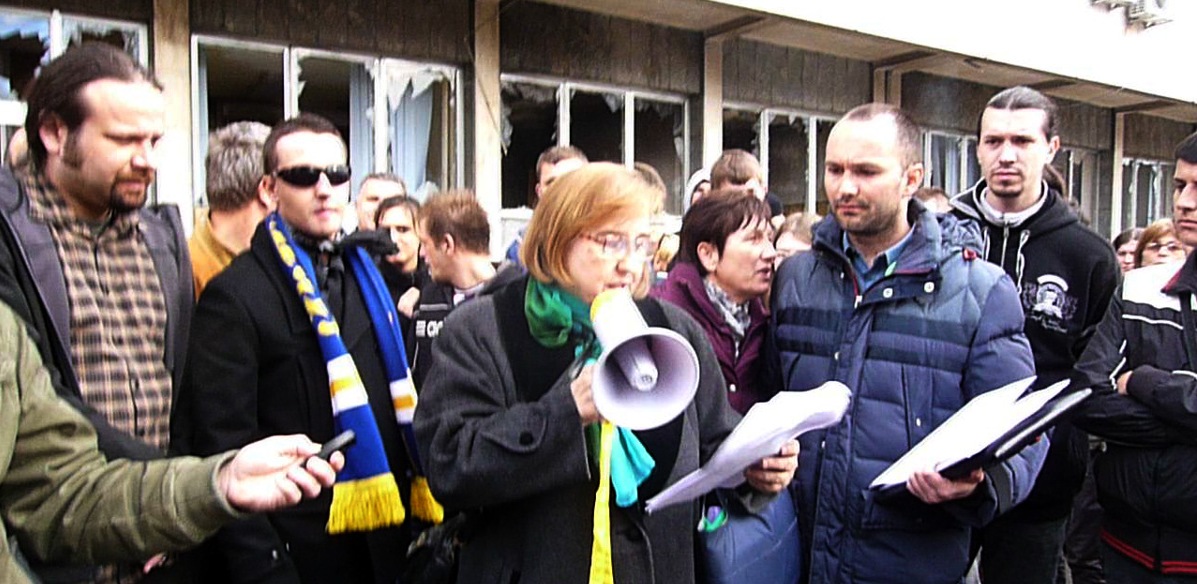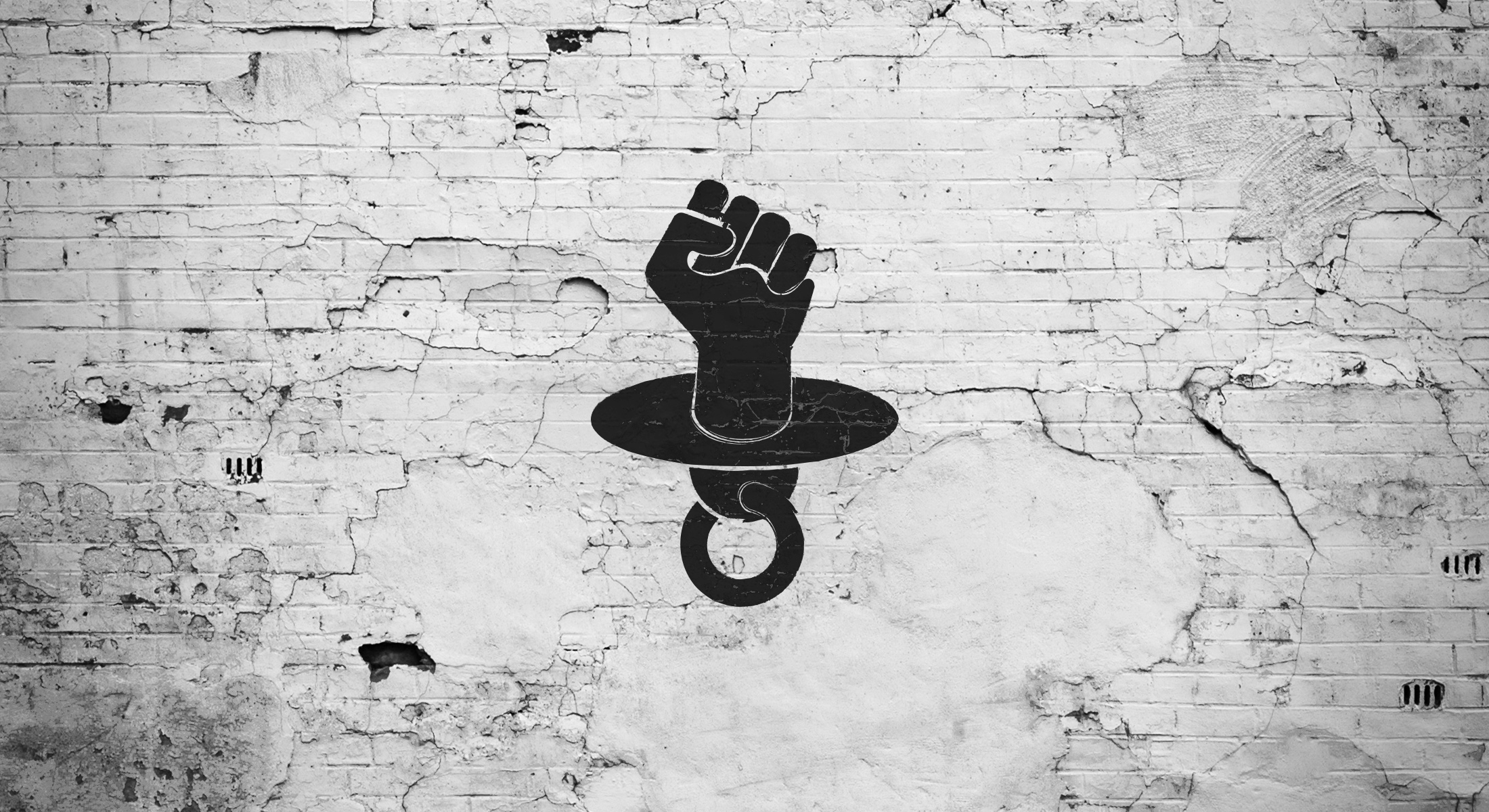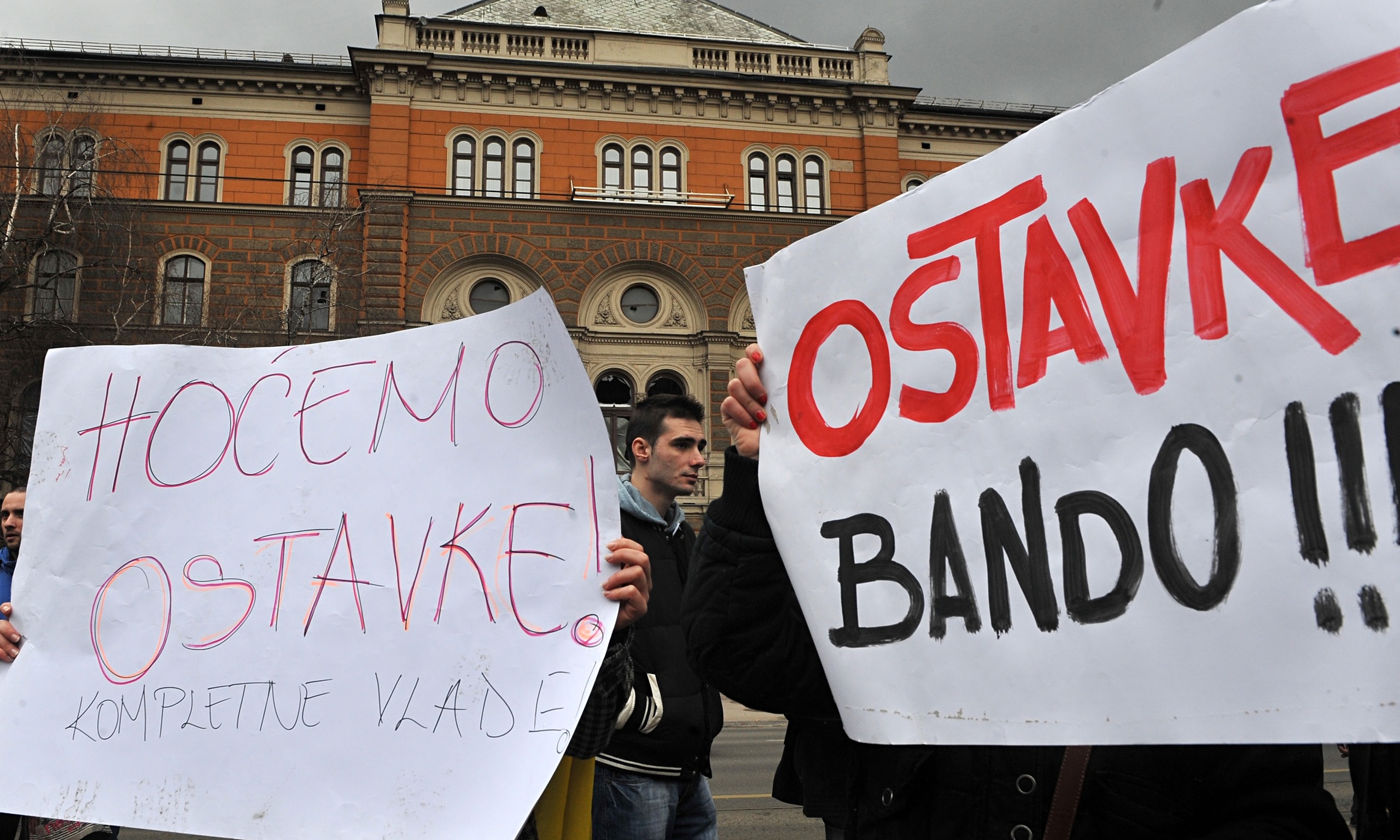In defense of the commons
Asking for resignations of the entire government
Plenums are informal assemblies of citizens that emerged out of the February 2014 protests, of “the humiliated and insulted” in Dostoyevsky’s terms, and as such they reflect a plurality of voices and multitudes untied in overthrowing the comprador, profiteering elites in power in Bosnia and Herzegovina. For the first time since the 1992-1995 war, there were individuals and collectives instead of bureaucracies and institutions, a.k.a. ethno-nationalist political parties holding uninterrupted power for almost twenty years after the Dayton, who came together in renewed solidarity in sharing common past, bodies, goods, and goals in what they recognize as a state of exception (Agamben 2005). The plenums/protests in Bosnia are the greatest “event” (Badiou 2007) after the peace followed by the 1992-1995 war and as such they are articulating the new political. Wo(men) that poured onto the streets present a point of breaking and entering into the public space and are a rupture within the register of current political practice.
What unites the protesters and plenum members is the struggle for the commons understood as a unifying potential for many ongoing fights that challenge the current political and economic system. The term “commons” has historically been used to denote natural commons like land and pastures originally referring to the 16 century England process of enclosure fundamental in the formation of capitalist relations because it concomitantly secured the landless labor class and the initial accumulation of capital (Dolenec et al. 2014). Enclosure happens continuously in capitalism as “accumulation by dispossession” (Harvey 2003) and presents the very logic of capital extending to ever-new domains of society. In the Balkans, many social spheres have been exposed to demands for privatization and pressured into demonstrating their short-term economic value, while private ownership is invariably presented as a superior solution. The accumulation by dispossession following the wars of the 1990s has been the driving force of expanding capitalist relations, pushing struggles for the commons to the center of political mobilization. The protests and plenums currently happening in Bosnia embody this mobilization.
Plenum as the new political event: filling the void

What does, then, plenum mean as event, and is it to be read as such? Be it an amorous encounter (love at first sight), political (revolution), or scientific (the eureka), an event is predicated upon a “forcing chance once the moment is ripe for intervention” (Žižek 1999: 187). Despite inevitable historicity, the end of which after Zuccotti, Tahrir, Syntagma, Maidan and the like we now know is not capitalism, the event in Badiouian terms is often entirely eruptive and cannot be deduced from the situation. Even though the protests/plenums could be viewed as an inevitability of the post-socialist and post-war social exploitation, they are part and parcel of a larger surge of discontent with neoliberalism all over the world redefining the meaning of activist citizenship of today. Miraculous or not, in spite of Bosnia’s semi-peripheral geography, they can be viewed as an inevitable force that befell the comfortable ethno-nationalist oligarchs in the postwar Bosnia who have for too long uninterruptedly enjoyed their privileges and were even rewarded by the international community for doing so after 1995 under the pretext of democratization (Majstorović 2007).
The Bosnian plenums/protests are an ultimate response to injustice ensuing after the alleged peace in B&H that divided the country into two entities, Republic of Srpska (Republika Srpska) and the Muslim-Croat Federation of B&H (Federacija B&H) and the Brčko district securing consociation of three constitutive peoples, i.e. ethnic groups such as Bosniaks, Serbs and Croats as they goal is to act as a corrective to the existing governments. These assemblies, created in the aftermath of social unrests, shattered the post-Dayton Bosnia to the bone when protesters went onto the streets burning government buildings and demanding resignations. As such, they derive legitimacy from the streets and squares expressed in the substance of a demand. Since the protesters managed to overthrow several cantonal governments in the Federation of B&H, their legitimacy comes out of the procedural legality.
The plenums’ organization is similar to a governmental one as they have formed working groups similar to the existing ministries: there is a working group for education, health, industry, energy and mining, workers’ cooperation and interplenum cooperation to name but a few. In May 2014, there have been over twenty plenum sessions in Tuzla, which is the most organized plenum in the country, followed by similar but less frequent plenum meetings in Sarajevo, Mostar, Bihać, Zenica etc. After the initial hundreds and thousands of people in the streets, protesters in the street somewhat dwindled while plenums continued meeting and working often with a couple of hundred of people attending the plenum sessions. Now they are being restructured and their work continues through local initiatives, several plenums such as those in Zenica and Gračanica still being active, and jointly, through the Network 5F7, symbolically named after the 5th and 7th of February 2014.
While in the past people talked about what cannot be done, now they are talking about what can be done, which is why one of the first demands was their interrogation of the procurement of new cars for cantonal government officials and the abolition of the so-called ‘white bread’ allowances for politicians who continued getting paid even when they were no longer in office. All this time, the plenums/protests, even though filling the existing political vacuum, were insisting on their role of a corrective, not wanting to actually occupy the traditionally understood forms of authority. They comprised a variety of social actors from workers, professors, journalists, intellectuals, non-governmental organizations (Lijevi, Udar, Velika djeca), soccer supporters, the unemployed etc. All this time the demands were articulated as greater social justice for all as the dominant political parties were seen as cynical and too concerned about their privileged positions. They have tried to criminalize the protests using the media spins, label and slander all the while hoping to denigrate and undermine the protests hoping the public enthusiasm will wear off.
In one of the first visits of the EU Enlargement commissioner Stefan Fuele to Sarajevo on 17 February, 2014, just ten days after the protests, he met with the political parties and refused to discuss the protests . By this act, he showed the EU attitude towards the first serious grassroots democratization efforts in the country where since 1995 an unprecedented amount of foreign aid was given to secure democratization, little of which actually had happened in practice. Only a couple of months later, in July 2014 a new document laying out the EU preconditions, called Compact for Growth and Jobs , was created designating a shift in the EU stance towards Bosnia popularly termed “The British-German” initiative . Although rather vague, the Compact was endorsed by the BiH parliament without problems and has already been critiqued as another mechanism to “bring austerity measures” to an already weak economy. In the next months, it remains to be seen how this new precondition will be played out and what it will entail.
A short history of activist citizenship in post-Dayton Bosnia

If we look at what has been going on recently in the post-Dayton Bosnia, the efforts albeit modest, have been nothing short of courage. Direct democracy and creation of social resistance on the street by grassroots citizens’ associations or no-leadership movements in the last year in major Bosnian and Herzegovinian cities have also given way to expressing the political in non-traditional ways, going beyond nationalist options on offer by parliamentary parties in the country.
The Picin Park protests in the summer of 2012 (May-September) in Banja Luka were a citizens’ response to the illegal building of a business center/shoping mall in the place of an old Banja Luka park, known as the Picin park by the developer Mile Radišić, now fugitive , who received permits to demolish it in order to build a complex containing businesses and residences without public notice. Originally started as eco/green protests, they were soon articulated as political protests against the completely deteriorated economy, non-existent rule of law, corruption and illegal gaining of wealth by the local tycoons, all under the umbrella of politicians, including the Mayor of Banja Luka at the time, Dragoljub Davidović and the President of the Serbian entity, Milorad Dodik. At the first demonstration, in late May, a thousand people marched and although the number of ‘walkers’ dissipated in the following months, it was the most articulated protest after the 1992-1995 war ever to take place in Banja Luka (Dolenec et al 2014).
The protester published a declaration, the language of which is undeniably political and calls upon issues such as commonness, the party-rule (partocracy), definition of the new political etc. as some of its segments read like a left manifesto previously unheard of in postwar Bosnia:
We, citizens of Banja Luka showing solidarity in spite of our differences and united in our antifascist commitment, have gathered in our joint struggle against the force and control of life, for the rule of law and not the oligarchy of politicians…Now it is clear, we live in a partocractic dictatorship of the criminal oligarchy and we are a multitude resisting it! …When fear disappears, tyrants, dictators, autocrats and false authorities start to fall…The park is a metaphor of commonness enabling us to communicate and act…We don’t shun the political meaning of this story, through the protest we turn the personal into political and vice versa.
Another round of protests, popularly called “Bebolucija” (Babylution) happened in Sarajevo, a year later, when in June 2013 the case of the three-month old baby Belmina Ibrišević from Gračanica, who needed to travel abroad for urgent medical treatment, but could not leave the country because she was not allocated an ID number and could therefore not get a passport, assembled citizens protesting in front of state institutions of B&H in Sarajevo. Starting as protests demanding that the Parliament immediately adopt the law on citizen IDs on the national level, it became an act of collective criticism of the dysfunctionality of the Dayton peace accords and ethnic-based violence it legitimated. All of these struggles, linked up in the struggle for the common good, may be good examples of debunking and openly challenging the power of dominant political elites in the country and their accumulated wealth and a good sign that, almost twenty years after the war, the situation in Bosnia and Herzegovina is changing (Dolenec et. al. 2014).
What is new about the protests and plenums that started a little over half a year after the JMBG or “Bebolucija” protests in February 2014, popularly called the “Bosnian spring,” is the shorter time between the JMBG protests, the fact that they have an unambiguously class character, the fact that they started in a city with the largest workers’ population and the largest unemployed worker’s population showing that the so-called ‘losers’ of transition rose up as they had nothing to lose, and the fact that they have spread so quickly across the Federation of B&H. One could argue that the higher value of ethnicity than class consciousness played a role in the relatively more peaceful entity of the Republika Srpska, yet the level of discontent there is hardly lesser. The ideological repression in the RS, mostly in the sphere of politic, media and education, does not let a dissenting voice be heard lest it is labeled a traitor of Serb national interests and the still strong power of Milorad Dodik and his party apparatus made it possible for only the former war veterans’ protests on 28 February 2014, while critical voices, with the exception of online media such as www.6uka.com or Slobodan Vasković blog (blog (http://slobodanvaskovic.blogspot.com) largely remain underground.
The language of the new political or is there an ‘after-plenum’?
Bosnian ‘schizophrenic’ situatedness is interesting here, albeit a European periphery it is also a potential place of possible articulation. On one hand, there is little critique of ethno-nationalist ideology and neoliberalism, the official state discourse is often the one of silencing, erasing and ignoring or merely indifference, and there is no minimum consensus on the past. Yet, something is emerging in Bosnia and that something is calling for a new language, a language of the ‘new political’. So far the discourse and practice surrounding the official politics embodied in the actual depoliticization of the “peace reconciliation and tolerance discourse“ used to preserve and cement the Dayton-based ethno-nationalist order. What we need here is to dispense with the old tropes and coin new ones in which the former workers, for example, are no longer the losers of transition, but in fact active agents of its work conditions transformation. We need public intellectuals to stand united in solidarity with workers in order to repoliticize the current order and critique the ethno-nationalist ideology opening what Diana Brydon (2006) calls “dillematic spaces of difficult engagements…through an infinite rehearsal rather than seeking final solution.”
Following Badiou, the emerging political should come via a ‘brutal distancing of the state’ as for Badiou, the separation between politics and the state lies at the very root of politics (Bensaid 2010). Just as when Yugoslavia and its socialist politics dismantled, the ethnopolitics resurrected resulting nation building through ethnic cleansing. The ‘Bosnian spring’ protests and plenums are indicative of the new political in that they don’t even deal with Dayton-based expectations, such as the constitutional changes or even more liberal rights for non-constitutive ethnic minorities such as Jewish and Roma reflected in the Sejdić-Finci case . As such, they go beyond identity politics towards a new class politics, or, in Gramsci’s words, a subaltern politics, a politics of the oppressed, which is the only conceivable form in which politics can endure once it has vanished under the pressure of totalitarianism or the market (Bensaid 2010).
As such, the plenums are demanding an end to the theft of public goods reflected in their demand for revised privatizations and society based on social justice. They are against the political class that has become divorced from the people and the discredited and exhausted institutions of political representation, which was most notably visible in the burning of the Bosnian Presidency building in Sarajevo.
In this sense, plenums can be regarded as an authentic will to change the existing regime articulated as the new political imaginary in the shape of demands, violent acts, demonstrations and protests that as such present a rupture in the ‘normal’, depoliticized, ethno-nationalist order of bodies and language compelling us to think differently. This struggle at the European periphery, the so-called ‘abandoned backyard of Europe’, is even more precious as many will and are trying to undermine it, to let it wear off, and to discredit it, especially the local politicians who cannot be expected to relinquish their wealth and influence without putting a fight. Whatever the result, causes will be investigated by neither he OHR nor the IMF nor the world metropolises, rather, for the “outcome management,” new reliable partners will have to be sought and new solidarities will have to be formed.
Is there an “afterplenum?”
Perhaps the question is set up wrongly as it implies some sort of completion in an afterlife that will ensue once the plenums are done with. This is usually done by drawing on two parallel universes: the one of the so-called realpolitik, or in Bosnia, the parliamentary democracy as a space inhabited by the dominant political parties in parliamentary assemblies, and direct democracy inhabited by the plenums and exercised in the streets. This reveals a false dichotomy as the reality of the political party rule has been the one of ethnic nationalism maintaining ethnic divisions while securing their uninterrupted control of assets obtained through accumulation through dispossession, both during the war and after selling what once was the property of the dissolved state of SFRY once again show the strong marriage of ethnic nationalism and capitalism. Juxtaposed to this, plenumpolitik is unique in that it does not ask for what has in the post-Dayton years been termed ‘political’ such as the constitution amendments even those many intellectuals who support or are are within plenums have been rather critical of the Dayton- based consociational constitution (Jovanović and Arsenijević 2011). Plenums and their remains are demanding social justice and social justice for all extending beyond ethnic, gender and class divisions: people are learning it by doing it and as such it presents a politics in action.
We would rather not have the ‘after-the-plenums’ scenario for it will inevitably go back to the aforementioned ‘realpolitik’ that has unfortunately been the post-Dayton impasse as politics of party deals, exclusions, and ethnic terror. Should Bosnia decide to exercise the activist citizenship shown after 7 February 2014, the only ‘after’ of plenums should be the one in which its work and impact resonate and shape the politics in the country by actively transforming it and filing its meaning with the true art of the impossible.
